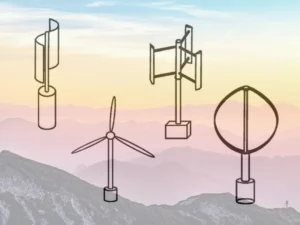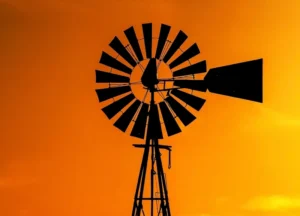The different Types of Wind Turbines
If you are fascinated by wind power generation and would like to learn more about the world of turbines, you have come to the right place. This article will walk you through the different types of wind turbines available, exploring the various blade shapes and innovations behind them. You will find out everything you need to know about horizontal and vertical axis wind turbines, as well as turbines that take advantage of the Magnus and Venturi effect. Everything you need to know before buying your next wind generator kit.

So let us begin with a brief overview of the different forms of wind turbines. Wind turbines can be categorized primarily into two types: horizontal-axis and vertical-axis. Horizontal-axis turbines are those we commonly see in wind farms, with blades rotating around an axis parallel to the ground. On the other hand, vertical-axis turbines have an axis of rotation perpendicular to the ground, and their blades rotate in a vertical plane. As far as Wind Turbine Efficiency is concerned, the type of axis is not relevant. What matters is the shape of the blades, which we will see below.
Types of horizontal-axis Wind Turbines
2-6 Blades

Horizontal axis wind turbines with 2-6 blades are among the most popular technologies for wind power generation today. Two-bladed turbines are generally more aerodynamically efficient, but tend to be less stable. Three-bladed turbines, which are more common, offer a good balance between efficiency and stability.
Turbines with four or more blades, although less efficient, provide more torque and are preferable in low wind situations or for applications requiring high torque loading such as water pumping. The blades are designed with a tapered, curved shape to capture the maximum amount of energy from the wind.
Farm Windmill multi-bladed

Typical farm wind turbines, often called windmills, are characterized by numerous blades and high torque. These are not designed to generate electricity, but rather for pumping. They are generally used to pump water from underground wells, a basic requirement for irrigation in rural areas. These wind turbines, have a robust design and operate at relatively low speeds. They represent an environmentally friendly and efficient solution to support agricultural operations.
Types of vertical-axis Wind Turbines
Savonius
The Savonius wind turbine is the typical vertical axis wind turbine. It is named after its inventor, Finnish engineer Sigurd Johannes Savonius. Although not as efficient as horizontal-axis models, the Savonius has the advantage of being able to capture wind from any direction. And it is one of those blades that indirectly exploits the Venturi effect. This makes the Savonius turbine an excellent choice for areas with unpredictable or variable winds. These types of blades greatly simplify the transmission mechanism. And just with different types of transmission and reductions, it can be suitable for both electrical and mechanical power generation. In the video below, a wonderful working DIY prototype.
Darrieus
The Darrieus wind turbine, named after its French inventor Georges Darrieus, is a type of wind turbine that uses the principle of aerodynamics to capture wind energy. This turbine has a unique design with curved blades that resemble a kitchen mixer or trophy. When the wind hits the blades, they begin to spin around the vertical axis, generating electricity. The main advantage of Darrieus turbines lies in their ability to capture wind from any direction, as in the Savonius, making them suitable for areas with variable winds or turbulence.
Gyromill
The Gyromill wind turbine represents a revolution in wind power, standing out for its unique design and exceptional energy efficiency. It is another evolution of the Savonius. Unlike conventional wind turbines that require strong winds to generate power, the Gyromill can operate in light breezes, making it an ideal solution for areas with not so intense winds. In addition, its vertical construction allows for very easy installation.
Magnus
The Magnus wind blade is a revolutionary achievement in the field of renewable energy. This blade, which uses the Magnus effect to generate power, is emerging as one of the most efficient. The Magnus effect, which spins the blade when the wind blows, allows the blade to produce power even in light winds, making this technology very reliable.
Vortex
The Vortex is a revolutionary wind turbine distinguished by its lack of blades. This innovative renewable energy solution, developed in Spain, uses wind-induced oscillations to generate electricity. Unlike conventional wind turbines, the Vortex features a vertical cylindrical design that makes it safer for birds and less intrusive on the landscape.
The system consists precisely of an approximately 10-foot-tall cylinder attached vertically to a base by a strong elastic cable. Once exposed to the wind, the cylinder begins to vibrate back and forth and with the movement produces electricity. In addition, its bladeless design reduces maintenance costs and noise emissions, making it a more sustainable and quiet green option.
The Venturi effect and the Types of Wind Turbines
The Venturi effect is a fundamental principle of fluid dynamics that describes how the velocity of a fluid increases as it passes through a narrow section of a duct, while the pressure decreases. This effect is named after the Italian Giovanni Battista Venturi, who studied and described it in the 18th century.
The Venturi effect occurs in a duct or pipe when the diameter narrows in a section called a “throat.” When a fluid flows through this throat, the velocity of the fluid increases due to conservation of mass. In other words, the mass of the fluid entering the narrow section must equal the mass of the fluid leaving. And because the area through which the fluid flows is smaller in the throat, the velocity must increase to keep the mass flow constant.
The Magnus effect on Wind Turbines
The Magnus effect is a phenomenon that occurs when an object rotates as it moves through a fluid, such as air or water. When the object rotates, it causes the fluid around it to move as well. This fluid movement creates a pressure difference on the sides of the object, pushing it in a lateral direction.
In simpler terms, if you imagine a soccer ball being kicked with effect, the fact that the ball is spinning causes its path not to be a straight line, but to curve slightly. This is due to the Magnus effect. Athletes use this principle to control the trajectory of their throws or throws, as in soccer, causing the ball to move in ways unexpected by defenders.


3 thoughts on “The different Types of Wind Turbines”
Comments are closed.